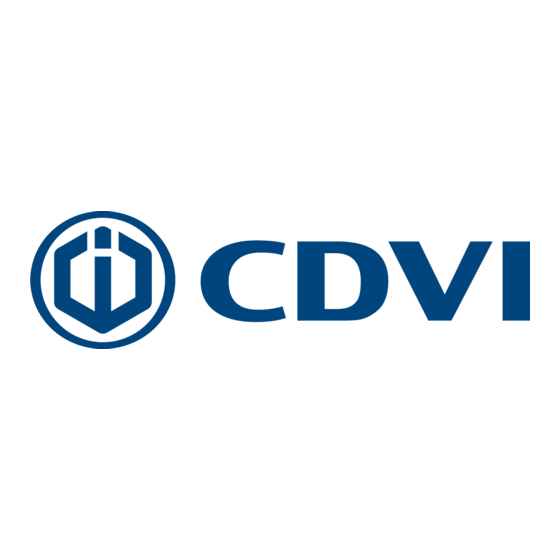Table des Matières
Publicité
Les langues disponibles
Les langues disponibles
Liens rapides
Publicité
Table des Matières

Sommaire des Matières pour CDVI DGLPTWLC
- Page 1 FRANCAIS ENGLISH DGLPTWLC Indoor/Outdoor Proximity Card readers - Wiegand Lecteurs Proximité intérieur/extérieur - Wiegand Range: Integrated access control / Gamme: Contrôle d’Accès intégré INSTALLATION MANUAL MANUEL D’INSTALLATION Group Products...
-
Page 2: General Information
INSTALLATION MANUAL DGLPTWLC Indoor/Outdoor Proximity Card readers - Wiegand 1] GENERAL INFORMATION Wiegand 26, 30 and 44 bits. Audible and visual feedback Direct connection to the controller through the door controller (INTBUSW). Flush mount. Polycarbonate. Sealed (resin moulded). Connection by 4 pair 6/10th cable Input voltage : 12 V DC. - Page 3 INSTALLATION MANUAL DGLPTWLC Indoor/Outdoor Proximity Card readers - Wiegand 4] CONNECTIONS: DIRECT CONNECTION TO A CONTROLLER DIPSWITCH 1 & 2 POSITIONNING DIPSWITCH 3 POSITIONNING The buzzer and the LED’s can be controlled by the reader or by an external device.
- Page 4 INSTALLATION MANUAL DGLPTWLC Indoor/Outdoor Proximity Card readers - Wiegand 5] CONNECTIONS: CONNECTION TO THE DOOR CONTROLLER (INTBUSW) DIPSWITCH 1 & 2 DIPSWITCH 3 POSITIONNING POSITIONNING The buzzer and the LED’s can be controlled by the reader OFF/ON or by an external device.
- Page 5 INSTALLATION MANUAL DGLPTWLC Indoor/Outdoor Proximity Card readers - Wiegand INTBUSW (Door controller) DIPSWITCH 4 Terminal block : Motherboard POSITIONNING Input voltage - Pulls up 5V Input voltage + Open collector outputs: Data O Clock Data 1 Pull up 5V Terminal block : Motherboard N/C contact eletromagnetic lock (+) Select the output voltage.
- Page 6 INSTALLATION MANUAL DGLPTWLC Indoor/Outdoor Proximity Card readers - Wiegand 6] OUTPUT FORMATS 26, 30 AND 44 BITS WIEGAND Chronograms 0 logic 1 logic \DATA1 \CLOCK 50 μs 50 μs Open collector output with internal pulls up 1K at +5V or +12V according the ST4 position.
- Page 7 INSTALLATION MANUAL DGLPTWLC Indoor/Outdoor Proximity Card readers - Wiegand Format Wiegand 30 bits Signals output in open collectors with pull up in 30-bit hexadecimal format. The output format from the proximity reader is 30-bit wiegand (Signal: DATA1, DATA0 and CLOCK) and is structured as follow: 1 - First parity : 1 bit –...
- Page 8 Indoor/Outdoor Proximity Card readers - Wiegand 7] MOUNTING After checking that the fitting kit is complete, you can start the final installation of your reader. Fix the DGLPTWLC box inside the front panel Feed the cables through (near the head mounting...
- Page 9 INSTALLATION MANUAL DGLPTWLC Indoor/Outdoor Proximity Card readers - Wiegand cdvi.com cdvigroup.com...
-
Page 10: Presentation Des Produits
MANUEL D’INSTALLATION DGLPTWLC Lecteurs Proximité encastrable Wiegand - 125 Khz 1] PRESENTATION DES PRODUITS Wiegand 26, 30 ou 44 bits. Signalisation lumineuse et sonore Connexion directe sur la centrale ou par l’intermédiaire du contrôleur de porte (INTBUSW). Montage encastré. Polycarbonate. - Page 11 MANUEL D’INSTALLATION DGLPTWLC Lecteurs Proximité encastrable Wiegand - 125 Khz 4] RACCORDEMENTS CONNEXION DIRECTE À UNE CENTRALE POSITIONNEMENT DIPSWITCH 1 & 2 POSITIONNEMENT DIPSWITCH 3 Vous avez la possibilité de gérer le buzzer et les voyants en interne ou en externe.
- Page 12 MANUEL D’INSTALLATION DGLPTWLC Lecteurs Proximité encastrable Wiegand - 125 Khz 5] RACCORDEMENTS CONNEXION AVEC CONTRÔLEUR DE PORTE (INTBUSW) POSITIONNEMENT POSITIONNEMENT DIPSWITCH 1 & 2 DIPSWITCH 3 Vous avez la possibilité de gérer le buzzer et les voyants en interne OFF/ON ou en externe.
- Page 13 MANUEL D’INSTALLATION DGLPTWLC Lecteurs Proximité encastrable Wiegand - 125 Khz INTBUSW (Contrôleur de porte) POSITIONNEMENT Bornier 5 points : Carte mère DIPSWITCH 4 Alimentation - Pulls up 12 V ou 5V Alimentation + Pour les sorties à collecteur ouvert, il...
-
Page 14: Format De Sortie Wiegand 26, 30 Et 44 Bits
MANUEL D’INSTALLATION DGLPTWLC Lecteurs Proximité encastrable Wiegand - 125 Khz 6] FORMAT DE SORTIE WIEGAND 26, 30 ET 44 BITS Chronogrammes 0 logique 1 logique \DATA1 \CLOCK \DATA0 50 μs 50 μs Sorties en collecteur ouvert avec pulls up internes de 1K au +5V ou +12V selon la position de ST4 Format Wiegand 26 bits Format 26 bits hexadécimal. - Page 15 MANUEL D’INSTALLATION DGLPTWLC Lecteurs Proximité encastrable Wiegand - 125 Khz Format Wiegand 30 bits Format 30 bits hexadécimal. La communication s’effectue par une liaison de type Wiegand 30 bits (Signaux : DATA1, DATA0 et CLOCK). La trame est constituée d’une totalité de 30 bits et se décompose comme suit : 1 - 1ère parité...
-
Page 16: Montage
MANUEL D’INSTALLATION DGLPTWLC Lecteurs Proximité encastrable Wiegand - 125 Khz 7] MONTAGE Après avoir vérifié que le kit de montage est complet, vous allez pouvoir procéder à l’installation finale de votre lecteur. Réunissez le matériel approprié (Perceuse, tournevis, mètre,...) et suivez les recommandations de montage qui correspondent au lecteur que vous allez installer. - Page 17 MANUEL D’INSTALLATION DGLPTWLC Lecteurs Proximité encastrable Wiegand - 125 Khz cdvi.com cdvigroup.com...
- Page 18 MANUEL D’INSTALLATION DGLPTWLC Lecteurs Proximité encastrable Wiegand - 125 Khz cdvi.com cdvigroup.com...
- Page 19 MANUEL D’INSTALLATION DGLPTWLC Lecteurs Proximité encastrable Wiegand - 125 Khz cdvi.com cdvigroup.com...
- Page 20 Reference : G0301FR0318V04 Extranet : EXE-CDVI_IM DGLPTWLC CMYK A5 EN-FR 04 Creator of electronic access solutions *G0301FR0318V04* CDVI Group FRANCE (Headquarter/Siège social) Phone: +33 (0)1 48 91 01 02 Fax: +33 (0)1 48 91 21 21 CDVI CDVI CDVI CDVI UK...











